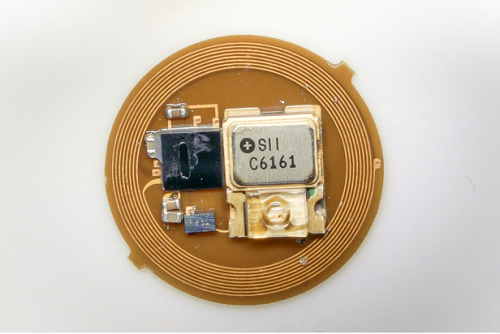By Warren Miller, contributing writer
Wearable technology is becoming smaller and less cumbersome with each passing day, but you still may find this one hard to believe. An enterprising professor of engineering at Northwestern University, with help from cosmetics giant L’Oreal, has developed a sensor used to measure exposure to ultraviolet light so small that it can fit on a fingernail. The device, dubbed UV Sense, just made its first public appearance at the 2018 Consumer Electronics Show (CES) in Las Vegas.
UV Sense is essentially a very small UV dosimeter that has no battery or mechanism. It can be affixed almost anywhere on the body (even on clothing) but is designed to adhere to the surface of a thumbnail. UV Sense users simply download an app onto their phone and then swipe their phone over the sensor itself to see how much sunlight they’ve exposed their skin to over the course of the day. The app can also measure body temperature, as well as suggest when to spend time outdoors without being overexposed.
In some places, overexposure to the sun isn’t the issue; underexposure is. In the Pacific Northwest, for example, it might be possible to not only check for overexposure on the rare sunny days but to also check for long-term underexposure when too many cloudy days block the sun from providing its health benefits. If large numbers of people were wearing similar sensors, the big data generated could help with clinical studies to zero in on the optimal mix of sunlight, vitamins, and diet for each climate region.
“We think it provides the most convenient, most accurate way for people to measure sun exposure in a quantitative manner,” said Northwestern engineering professor John A. Rogers. “The broader goal is to provide a technology platform that can save lives and reduce skin cancers by allowing individuals, on a personalized level, to modulate their exposure to the sun.”

The wearable tech can be customized with different coatings and designs over the electronic interface. Image source: northwestern.edu.
Rogers and his research team are collaborating with the Northwestern University Feinberg School of Medicine to employ UV Sense in clinical studies of sun exposure in subjects who are in a high-risk category of melanoma, an endeavor being co-funded by the National Institute of Health to the tune of a $2 million grant. “Sunlight is the most potent known carcinogen,” said Doctor June K. Robinson, a research professor of dermatology at Feinberg. “It's responsible for more cancers than any other carcinogen known to man, and it’s everywhere — even in Chicago.”
L’Oreal apparently agrees. As Guive Balooch, Global Vice President of the company’s technology incubator, said, “With this knowledge, we set out to create something that blends problem-solving technology with human-centered design to reach even more consumers who require additional information about their UV exposure.” Half the population of the United States alone gets at least one sunburn every year — if UV Sense can help raise awareness about just how harmful overexposure to the sun can be, it might end up being a cosmetic lifesaver.
Advertisement
Learn more about Electronic Products Magazine





